Serendipitous Connections
What does a picture in a steamer trunk, a man named Mircea Eliade, a researcher in Bucharest, Romania and a house at 82 Rippon Street Calcutta, India have in common?
(This post has been updated from one I wrote in 2013)
This story has its beginning with a picture in a steamer trunk kept in our basement. Not only did the trunk store Christmas decorations, it held pictures from the past. I had seen these pictures each December when my mom got out her decorations. Mom said these pictures belonged to my grandmother Sarah Jane Sleath Perkins. Sarah Jane was the only grandparent I ever met and she died when I was only 7 years old.
Fifteen years ago when I first became interested in researching my family history, those pictures were the first things I decided to check out. Some faces I recognized, others I did not. I concentrated on the people I knew, did my research and moved on. It was only more recently when I became interested in telling the stories of individual ancestors that I returned to the unidentified pictures in the trunk. The whole point of this exercise was to see what I could discover about an ancestor and if it would be sufficient to develop a story. I chose the picture taken in the Punjab of a young man in an army uniform with the scribbled name “Dick”.
Over time, I learned a great deal about my Great Uncle Richard Edward Sleath, his wife Gwyndon Ophelia Mathias and her second husband William Frederic Perris. I did presentations on my ancestor’s life to both the England Wales and Postscripts Special Interest Groups during the winter of 2019. To the latter, I was showing how even if you only had minimal in formation to start, it was possible to develop a story.
Since Spring 2019, the story itself has taken on a life of its own and recently put me in touch with a Romanian, Liviu Bordas in Bucharest, who just happened to be researching the Perris Family of Calcutta, India. I am getting ahead of myself though and must return to first telling you what I discovered about my ancestor, Richard Sleath. After that I will explain how his story morphed into a story for Relatively Speaking.
I knew my maternal grandmother, Sarah Jane Sleath, had a number of brothers and that one or more had served with the British Army. I had her 1901 wedding photo taken in Claybrooke, Leicestershire, England. The young man called Dick was not in the picture so it was possible, if indeed he was Sarah Jane’s brother, that he was stationed somewhere with the British Army in Punjab, India.
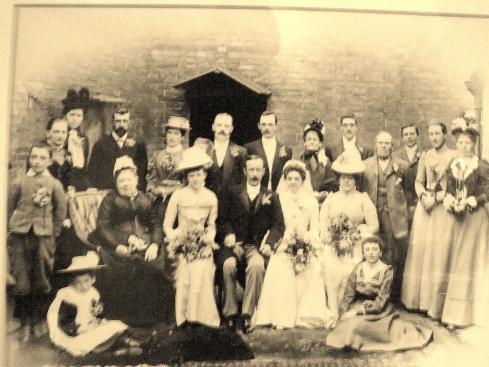
Wedding was at St. Peter’s Claybrooke Parva. Sarah’s parents George and Abigail Seath and her brother’s George, Jack and Thomas are in the group. Richard Edward Sleath not in picture.
I referred to a pedigree chart I had developed when I was researching the Sleath Family. Sarah Jane was born in 1869 and her brother Jack in 1866. These were the two Sleath siblings that had ended up in Alberta in the early 1900’s. There was one older brother and 4 younger brothers that remained in England.
As I have a number of paid genealogy sites, it was natural to access them to discoverer what information they might hold. I first went to Find My Past UK and located a baptism record for Richard Edward Sleath. He was christened at St. Mary’s Parish Church in Moreton, Staffordshire on Feb 25, 1872. This document confirmed his parents were George and Abigail Sleath, the same as Sarah Jane. On the 1881 Census on Ancestry, I found the family living in Streethay, Staffordshire. This document confirmed the names and ages of all the family. It appeared that George and Jack (John) were the older brothers while Richard, Joseph and the twins, Thomas and Samuel were the younger brothers. Sarah Jane was the only girl.
On Ancestry I was fortunate to find Service Documents from the UK Royal Hospital, Chelsea, Pensioner Soldier Service Records 1760 – 1920. I was referred to Fold3 (owned by Ancestry) for the original documents. These records gave me a summary of Richard’s military career.
Summary: Richard Sleath - Military Career
1889 – joined the 4th Battalion Staffordshire Reg as a Militiaman
23Sept1889 - joined King’s Royal Rifle Corp at Winchester (86267)
08Aug1891 - posted to Royal Horse Artillery Dublin District formed in 1793 as distinct arm of the Royal
Regiment of Artillery
26May1892 – appointed as a Bombardier, a military rank that has existed since the 16th century in artillery regiments of various armies equivalent to the rank of corporal in other branches.
09Sept1893 - sent to India to fight on the NW Frontier 29Sept1901 _ discharged at Allahabad Railway Station, Northern India
It was at this point that I had to get myself a good map of India in the 1890s plus smaller maps of the various provinces. I really had no idea where anything was and how far apart some of these places were. I also had to delve into the history of the country. It certainly wasn’t covered in my High School classes.
I found a book on Google called North-West Frontier 1837–1947 by Robert Wilson Latham There was a summary as follows:
“For over a hundred years British and Indian troops were engaged on the North-West Frontier of India, policing the tribes, mounting expeditions, and guarding against the ever-present threat from Russia. Populated mainly by Pathans, one of the fiercest warrior races on earth, the Frontier came to be known as “The Grim” by generations of British soldiers. It offers a rare glimpse into life on the Frontier, illuminating Lord Curzon’s remark, “No man who has read a page of Indian history will ever prophesy about the frontier”.
I don’t know where Richard was stationed or what battles he may have been in. I do know that he was shipped to India in 1891 with the Royal Horse Artillery as a Bombardier and he was discharged at Allahabad Station in 1901.
I created a Timeline to help in writing the story of Richard Edward Sleath.
1872 Baptized in Moreton Staffordshire
1881 Living in Streethay Staffordshire
1889 Militia Man in Lichfield Stafffordshire
1889 Joined Kings Royal Rifles
1891 Dublin District Royal Horse Artillery Gunner
1893 India Bombardier (Rank between that of gunner and that of sergeant) Royal Horse Artillery
1901 Discharged at East India Railway Station Allahabab
1902 Married Gwyndon Ophelia Mathias at Khagole, Bengal, India
1907 Richard Sleath died 24Feb1907
1908 Gwyndon Sleath (Richard’s widow) marries William Frederic Perris
Richard was discharged from the British Army in 1901. He would have been 29 years old. As I was searching for pictures of the East India Railway Station at Allahabad on the internet I found a postcard. It had been written by Adelaide in July of 1908. She was letting someone know she was leaving from the Allahabad Station. It struck me that this was the same station Richard would have seen.
The steamer trunk held other photos including one of Richard Sleath in civilian dress. He looked older than the man in the army uniform. I guessed the photo would have been taken after he had been discharged from the army in 1901. The photographer was identified as Bourne and Shepherd of Calcutta. I thought this picture might have been taken around the time of his wedding (1902) and one that he would send to his sister Sarah Jane.
I located an Extract from India Eagle Paper in Calcutta and learned something about this company.
Bourne & Shepherd: World’s Oldest Operating Photo Studio in Kolkata Breathed its Last (2016)
“This dilapidated building named ‘Photographe’ in the busiest neighborhood of Kolkata could have been converted into a world-class photography museum to preserve the footprints of India’s journey from the colonial times to the post-independence era. But Fate had something else in store for the iconic landmark where many historic events across the country were documented through photography for 176 years…..the photo studio was renamed Bourne & Shepherd in 1866 when the British photographer and traveler duo – Samuel Bourne and Charles Shepherd – took control of the business after William Howard left India.”
What happened to Richard Sleath following his discharge? This was an important question I needed to answer. I discovered a marriage registration on findmypast.co.uk. He had married a woman by the name of Gwyndon Ophelia Mathias at Christ Church, Khagole, India on September 25,1902. This record was part of the British India Office Collection . He said he was 28 and she was 17. In actuality he would have been 30. Yes our ancestors stretched the truth!

Richard Edward Sleath married Gwyndon Ophelia Mathias on 26 Sept 1902 at Khagole Bengal India
I had the wedding picture for Richard and Gwyndon. Given the style of the wedding dress this had been a very English wedding. The couple were married for only five years when Richard died February 24, 1907 in the Medical College Hospital in Calcutta at age 35. This information was from the Times of India newspapers on the Families in British India website. I could not find a death record. He was an employee of the East India Railway Company.
I located Richard’s will on Find My Past. It would appear that he was living a very good life in India and based on conversion rates for the rupee to today’s purchasing power in UK pounds, Gwyndon was a moderately wealthy widow.
“I give…my household furniture, linens and wearing apparel, plates, pictures, china, horse carts and carriages and also every sum and sums of money which may be in my house…..also my stock funds and securities and all and every other money or bank notes or other securities.”

John Mathias and Ophelia Grose (Gwyndon Parents) were married at St. Paul’s Church on Scott Lane in Calcutta, India in 1862
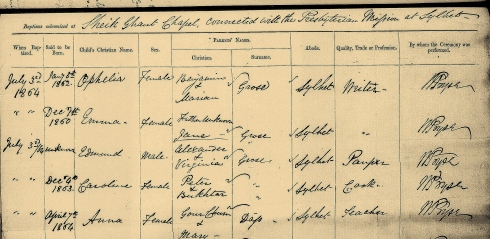
Ophelia Grose (Gwyndon’s Mother) was born 1862 and christened 1864 at the Sheik Ghaut Chapel Associated with the Presbyterian Mission of Sylhet. She was the daughter nof Benjamin Gilbert Grose and Marian ? Interesting to note other children named Grose were also christened at the same time.
I could end my story at this point. My ancestor is deceased and he left no living children. Gwyndon, at 22 would move on with her life. Indeed she married William Frederic Perris in 1908.

Family Photo…Richard Sleath, Gwyndon Mathias Sleath, Ophelia Grose Mathias and John Mathias. Unknown woman in top left….sister, aunt?
I was curious though, as to what would happen to such a young woman. I thought why not do some additional research into Gwyndon Ophelia and her maternal family. From the family picture it was clear that her mother Ophelia was an Anglo-Indian. This woman after whom she was named came from Sylhet, Bengal in northeast India. The family name was Grose. I found Ophelia’s father Benjamin Gilbert Grose born 1840 in Sylhet and his father Robert Grose born in Calcutta in 1808. Robert’s father was John Grose but I was unable to determine where he was born.
On the Perris side we find her husband Wiliam Frederic Perris born into a military family in Bareilly, Uttar Pradesh, India in 1879 to Corporal and Amelia Perris (2nd of the 2nd Queens). He married Gwyndon Mathias Sleath in 1908 and they had 6 children. The senior Perris’ ended up in England in 1951 following the partition of the country.
This is where the story takes a serendipitous turn. I had advertised my presentation to the Postscript group on my Facebook Page. Liviu Bordas a Romanian researcher saw the post on Facebook and got in touch with John Althouse. The following morning I had a forwarded email from Liviu Bordas. Liviu had being trying to reach me since finding my blog, A Genealogist Goes Wandering, on which I had a posting about Richard and Gwyndon Sleath and William Frederic Perris.
Liviu writes: May 2019
“I am doing a research on Calcutta (and generally India) during the last period of the British Raj in connection with some European scholars who visited or lived there for some time. In 2015, I have researched the India Office Records in The British Library and National Archives and found some information. I found other information, including their migration to UK, on various genealogical websites. I would like to know what you have found. Thank you.”
Emails went back and forth. I wanted to know why he was researching the Perris Family. Turns out he was researching a noted Romanian religious scholar Mircea Eliade who had stayed with the Perris Family in their Calcutta guesthouse from 1929 to 1931. He was writing a book soon to be published and wanted permission to use some of my pictures.
Liviu Wrote in reply to one of my emails: “Their entire life is a great story. I wrote it. 🙂
I put all the information I could find about them (their lives and their ancestors) in a text I wrote as introduction to Mircea Eliade’s Indian travelogue (India) and Indian diary (Șantier = Work in progress), published in 1934 and 1935 (now republished in a single volume). Eliade lived in their house for the duration of his stay in India (January 1929 – November 1931), except for January-September 1930, when he lived in the house of his professor, Surendranath Dasgupta. The Perris kept their rented home in Calcutta as a “pension” / “guest house”. In India, Eliade mentions, briefly, only Fred Perris and his brothers. But in Șantier all of them, including Ophelia, Gwyn’s mother) are a constant presence. Isabel is modeled after Gwyndon, while Maitreyi is Maitreyi Devi, Dasguptas’s daughter. Almost all the other Perris appear under a guise in the two novels. The last one is the only one translated in English and made into a film – Bengali Nights. Eliade also kept a correspondence with the Perris family while he was traveling in India and after his return to Bucharest as well, until 1936.
The book is coming out in a week or two. I have quoted your blog post and also included one of the pictures (with Richard, Gwyn and her parents) mentioning as source the personal archive of Louise Perkins”. I apologize for doing it without securing your permission. I have tried to contact you in October and November but received no answer. Unfortunately, the publisher made the picture very small, so I think there is no much use of it in the book. The readers can go however to your blog post. I hope you won’t mind that. Let’s keep in touch. We might find other things to share. With best wishes,” Liviu
Serendipitous connections kept occurring. I found a book in a bookstore on Whyte Avenue. It contained additional information about the family and their lives when Mircea Eliade was staying there. He refers to Gwyndon Perris as Mrs. P who ran the establishment at 82 Rippon Street.. Her sons were the same age as Mircea, all in their late teens or early 20’s. I await the publication of Liviu’s book and translation to English. Who knows what else I might discover?

The young man that lived at the guest house in Calcutta belonging to The Perris Family (Gwyndon was Richard Sleath’s widow. Married Fred Perris in 1908.
As an ending to this story, I discovered a further connection to a man I had never heard about until May 2019. I was taking a class and the speaker was David Goa, (Adele Goa’s brother for those of you in the know). He is a noted Religious Scholar and curated the Anno Domini Exhibit at the Royal Alberta Museum in the early 2000s. I thought I would ask him if he was familiar with Mircea Eliade. He looked at me and said “of course, he was my professor when I studied at the University of Chicago in the 60’s. He was a brilliant man!” It is indeed a small world!
What does a picture in a trunk, a man named Mircea Eliade, a researcher in Bucharest and a house at 82 Rippon Street Calcutta have in common? I have discovered that they form the basis for a very interesting story and now you know the answer!

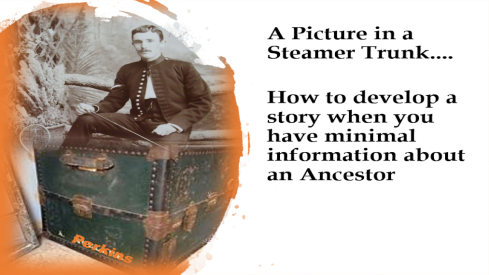
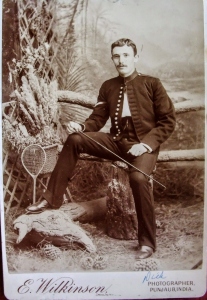









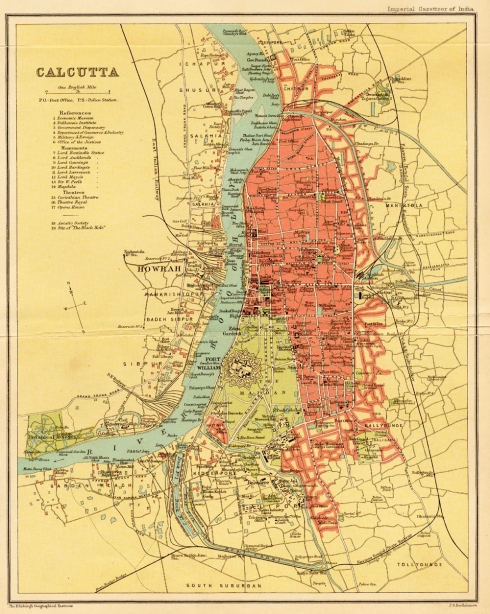



Hi Louise Thanks for this. It’s really fascinating. I’ve printed it up and also passed it on to some friends who are Anglo-Indian and grew up in Calcutta. I’m still finishing off the final proofs for my memoir, and dealing with the photo pages now. It’s been a long hard job but worthwhile, I feel. Maybe you should try writing an entire book, as well! I’ve included that family group photo in front of the big house with SHOTTON printed over the door, but of course it’s been copied so many times the lettering and the features of the people are not as clear as they could be, but can’t be helped. I wish I knew exactly where it was taken, but couldn’t find it during a drive-round of either Walton or Barton, though of course it could have been either demolished or much altered by now. Must go – got more paperwork to do, and going to matinee with friends at the Derby Theatre later. Hope all is well with you. Love Brenda
LikeLike